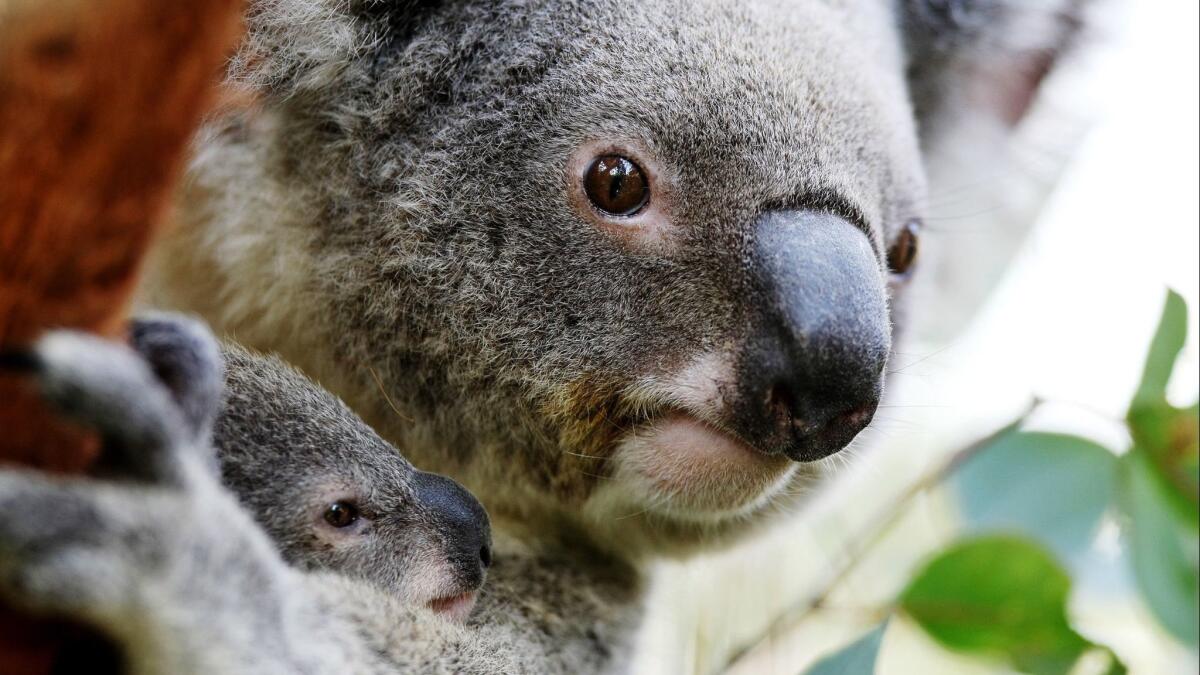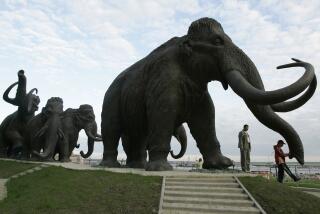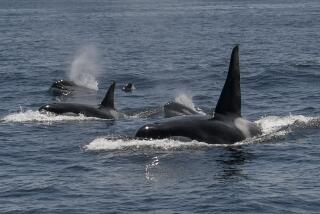The koalas are threatened. Can their genome help us save them?

- Share via
The koala is an unusual creature. Native to Australia and a bit bigger than a raccoon, it spends most of its time in eucalyptus trees, gorging on leaves that are toxic to nearly every other animal on the planet.
The koala sleeps about 22 hours a day and spends the remainder of its time eating and resting. It might spend 10 minutes a day moving, experts say, usually from one tree to another.
It spends so much of its life sitting around in trees that it has evolved a cartilaginous pad at the end of its spine and extra thick fur on its rear end to make the endeavor more comfortable.
Its life cycle is strange as well. Koala babies, called joeys, are born after just 35 days of gestation, when they are about the size of a jellybean.
Pink, hairless and blind, the newborn koala uses its tiny claws and highly developed sense of smell to make the harrowing journey from its mother’s birth canal to her pouch.
Once it arrives, it attaches itself to one of two teats, and subsists on her milk for six to seven months.
The unique lifestyle of the koala has helped it thrive for 350,000 years, but today the cute and iconic creature is facing threats from habitat loss, disease and a changing climate. Koala populations are expected to decline by 50% in the next 20 years, according to the Australian Museum.
To help protect these animals, which bring in an estimated $1.1 billion to Australia each year through koala-related tourism, an international team of researchers has published the first complete genome of the koala. Their hope is that the keys to the marsupials’ long-term survival might be embedded in its genetic code.
“The ultimate goal is that we won’t have to use ‘emergency room conservation’ and rescue them from the brink of extinction,” said Rebecca Johnson of the Australian Museum Research Institute in Sydney, who led the work. “Now we have a really good understanding of the koala genome, and we are in a fantastic position to use that knowledge to help us manage them.”
The koala genome has 26,000 genes, which makes it slightly larger than the human genome. It took a consortium of 54 scientists from 29 institutions five years to assemble it.
“It was not hard to get people involved,” Johnson said. “Not only are koalas super cute, but they have an interesting lifestyle and scientists were curious how it would translate to their genes.”
A preliminary analysis of the koala’s genome, published Monday in Nature Genetics, has already yielded some intriguing findings.
For example, the authors found that compared to other mammals, the koala’s DNA includes an expansion in the number of genes that encode for enzymes involved in detoxification. That allows them to have a diet that depends almost entirely of eucalyptus leaves, which are unusually high in toxins. However, it also means that koalas metabolize medications like anti-chlamydia antibiotics faster than other animals.
This is a meaningful discovery for koala conservationists, since chlamydia has proved to be a significant challenge for the koala population, especially in northern Australia.
The researchers conclude that while a single dose of chlamydia medicine might work for humans, koalas, because of their genetic code, will need a daily dose for up to 30 to 45 days.
The koala genome also revealed why koalas are such notoriously picky eaters. They are known to consume leaves from just 20 of Australia’s 600 known eucalyptus species. And even when they are in one of their preferred trees, koalas take leaf selection very seriously.
“They kind of stick their nose right in a bunch of leaves and then pick out two leaves they really want to eat,” Johnson said.
This behavior can be explained by an expansion in the number of genes involved in their ability to discern a bitter taste and their nasal receptors, she said.
The research team thinks that the bitter genes allow the koalas to pick out leaves with the least amount of toxins, while the nasal receptor expansion might help them sniff out which leaves have a higher water content. Since koalas get most of their water from their diet of leaves, this would be a useful adaptation.
These genes could have relevance for a conservation strategy as well, Johnson said. As more koala genomes are sequenced, scientists could see if koalas in different regions of the country have variations in their bitter genes that might make them better adapted to eating their local eucalyptus leaves. If that’s the case, then moving animals to different parts of the country to improve their survival rates could be trickier than anticipated.
The authors also found evidence that koalas in the north have more genetic diversity than those in the south, which are largely inbred. This suggests that the protection of koalas in the north is of primary importance in order to maintain a robust gene pool, the authors said.
This finding is also significant, especially since northern koalas are declining faster than those in the south.
Other discoveries include a set of genes that indicate that koala mothers provide their babies immunity from diseases in the first months of their life through their milk, and that the composition of that milk changes over the course of the joey’s development.
Johnson said that the information encoded in the koala’s DNA is already being included in management strategies by conservation groups. However, she said the findings described in the new paper represent the early stages of what can be gleaned from the marsupial’s genome.
“The data is public and I would love for anyone to start mining it and see what other amazing things they can find,” she said. “Once you have a genome of this quality, the sky’s the limit with what you can do with it.”
Do you love science? I do! Follow me @DeborahNetburn and “like” Los Angeles Times Science & Health on Facebook.
MORE IN SCIENCE:
Can humans reach even older age? We haven’t maxed out yet, some scientists say
Preserving more habitat for China’s giant pandas is having a giant payoff, study says
‘Oumuamua, the mysterious visitor from outside the solar system, is a comet after all







